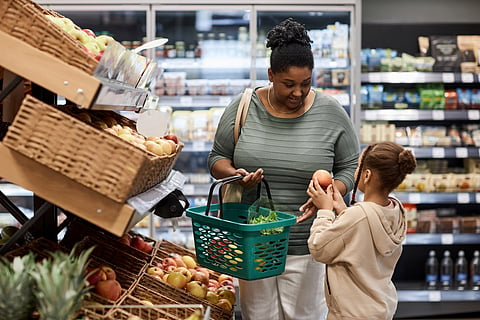OPINION | Congress Has Failed to Act on White House Proposal for Additional WIC Funding
by Danielle Marie Holland
As the U.S. Department of Agriculture (USDA) seeks to grow and improve maternal and infant health by connecting more people to the Special Supplemental Nutrition Program for Women, Infants, and Children, known as WIC, outreach has been stymied by a Congress that keeps kicking the funding can down the road in six-week increments.
"We're in a bit of a dilemma where it's difficult to grow if you don't have the additional funds," said USDA Deputy Under Secretary Stacy Dean to the Emerald. "Congress has given us the ability to spend more of last year's money in the early part of the year, and that's been very helpful. All states have the resources they need. But we can't do that forever because we're going to run out."
When the Biden-Harris administration proposed additional funding for WIC earlier this fall, Congress took no action. After the two most recent threats of a government shutdown, lawmakers on Capitol Hill are now expected to take on the federal budget in the new year, with the first budget deadline approaching on Jan. 19. While the USDA works to ensure a continued and historical bipartisan commitment from Congress to fully fund WIC, if Congress fails to take action to support increased participation, states would be forced to place eligible families onto waiting lists.
Washington State Sen. Patty Murray, head of appropriations in the Senate, indicated her full support of the program on X: "I will fight tooth and nail to make sure no one loses their WIC benefits or is put on a waitlist. Making sure families across the country with the tightest budgets can put food on the table is not just the right thing to do, it's an investment in these families' futures." The new year will see if Congress follows Murray's lead to secure these much-needed resources for families, mothers, guardians, and infants.
In the decades since becoming a permanent federal program in 1974, WIC has transformed into a vital food security program for millions of infants and mothers in America. One of 16 nutrition assistance programs offered through the USDA's Food and Nutrition Service (FNS), WIC provides "supplemental foods, nutrition education, breastfeeding promotion and support, and referrals to health care and social services to low-income, nutritionally at-risk pregnant women, new mothers, infants, and children up to age 5."
"WIC is one of our country's most powerful evidence-based public health programs," said Dean, referring to the recently released November WIC report. "There's a long and rich history of helping kids and babies thrive." The report findings surveyed 2021 national and state estimates tracking WIC eligibility population and coverage. For the first time, new data was included in the public report: urbanicity, or coverage by urban and poverty status, as well as participation rates by state, race, and ethnicity. A key takeaway in the report showed that nationally, more than 50% of WIC-eligible SNAP and Medicaid recipients are not participating in the program.
The report is rich with information telling us where states need to do better. WIC coverage in Washington State sits at 49.3%, or just under the national coverage average of 51.2%. Of the 245,800 eligible Washington participants in 2021, just 121,300 were enrolled in the program. Washington State data include estimates for Tribal organizations, which are not estimated separately. By contrast, states such as California are reaching 73% of those eligible. "This report gives us enough information to inspire, to know we can do better," said Dean, "through the White House proposal for additional funding."
The report breaks down coverage further by race and ethnicity. The "Hispanic/Latino" coverage in Washington State is 55.2%, with 49,400 participants out of the 89,500 eligible. The "white only-non Hispanic" coverage sits at 40.8%, with 43,300 participants out of the 106,100 eligible. The "Other than white-only/Non-Hispanic" coverage is 57%, with 28,600 participants out of the 50,200 eligible.
WIC eligibility and participation by state are also reported over time. Washington State coverage dropped by 5 percentage points from 2016 to 2021. This coincides with a decrease in state population eligibility, which was 50.5% in 2016 and 43.4% in 2021. In 2016, the maximum income eligibility for a two-person family was just over $16,000 and today it is just over $36,000.
The ongoing budget debates and gaps in federal benefit coverage expose the vital importance of community-based and mutual aid programs and organizations addressing food stability. In the South End, anyone in need of groceries can visit the Rainier Valley Food Bank on Friday or Saturday from 9 to 11 a.m. and 12 to 2 p.m. The South Seattle College's food pantry is open Wednesday and Thursday from 11 a.m. to 2 p.m. throughout the academic year. The White Center Food Bank is open by appointment throughout the week. These are just a few of our local community food programs keeping our communities fed, nourished, and thriving.
Danielle Marie Holland is an essayist, transformative writer, and podcaster. Danielle is a regular contributing writer at Parents Magazine, and her work has been published in DAME, Insider, Rewire News Group, and beyond. Her book The Body Still Remembers is forthcoming via Hinton Publishing.
📸 Featured Image: Photo via SeventyFour/Shutterstock.com
Before you move on to the next story …
The South Seattle Emerald™ is brought to you by Rainmakers. Rainmakers give recurring gifts at any amount. With around 1,000 Rainmakers, the Emerald™ is truly community-driven local media. Help us keep BIPOC-led media free and accessible.
If just half of our readers signed up to give $6 a month, we wouldn't have to fundraise for the rest of the year. Small amounts make a difference.
We cannot do this work without you. Become a Rainmaker today!
Help keep BIPOC-led, community-powered journalism free — become a Rainmaker today.


